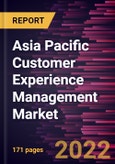The customer experience management market in Asia Pacific is expected to grow from US$ 2,676.57 million in 2022 to US$ 7,513.73 million by 2028. It is estimated to grow at a CAGR of 18.8% from 2022 to 2028.
Significant structural changes emerged from traditional business structures, resulting in a new, profitable concept called the`on-demand`business model. This business structure focuses primarily on providing direct customer-centric services, thereby expanding the customer base to meet customer requirements in a short period and be supported by superior customer products and services. Investors are primarily focused on investing in such companies, as these business models are based on higher rates of return combined with better customer service. For example, one of the most common causes of such large-scale funding is Uber, which received about US$ 8.6 billion in funding in 2016, and Airbnb, which raised about US$ 2.4 billion in 2016. The increasing popularity of the on-demand business model boosts the acceptance of omnichannel shopping experiences. Furthermore, the need to personalize consumer behavior led companies to embark on strategic initiatives expected to increase overall product sales and profitability.
Significant structural changes emerged from traditional business structures, resulting in a new, profitable concept called the`on-demand`business model. This business structure focuses primarily on providing direct customer-centric services, thereby expanding the customer base to meet customer requirements in a short period and be supported by superior customer products and services. Investors are primarily focused on investing in such companies, as these business models are based on higher rates of return combined with better customer service. For example, one of the most common causes of such large-scale funding is Uber, which received about US$ 8.6 billion in funding in 2016, and Airbnb, which raised about US$ 2.4 billion in 2016. The increasing popularity of the on-demand business model boosts the acceptance of omnichannel shopping experiences. Furthermore, the need to personalize consumer behavior led companies to embark on strategic initiatives expected to increase overall product sales and profitability.
Market Overview
Asia Pacific is one of the emerging markets for customer experience tool vendors as the region's information technology industry has grown subsequently over the last decade. According to a recent World Bank report, ~85% of the top 20 tech companies in APAC reported YoY earnings growth in 2021 despite experiencing inflationary pressures and supply chain disruptions caused by the COVID-19 pandemic. Furthermore, Taiwan continues to outperform the list of the top 20 APAC tech companies by sales, followed by Japan, China, South Korea, and Singapore. India and Indonesia are also growing due to emerging technology services. Hence, such factors are driving the customer experience management market growth. In addition, according to a recent report by SalesForce, executives across APAC support progress of CX technology, and 79% acknowledge that CEM is important for providing a seamless customer experience (CX). Furthermore, nearly half of all executives surveyed have confirmed that providing superior CX across multiple channels is a top priority for the next 12 months. ~81% of executives are anticipated to see CRM adoption grow beyond sales and service/support over the next three to five years, improving coordination between teams and customer experience. Such factors are likely to boost the customer experience management market growth over the forecast period.Asia Pacific Customer Experience Management Market Segmentation
The Asia Pacific customer experience management market is segmented into component, deployment mode, organization size, touch point, industry vertical, and country.- Based on component, the market is segmented into solution and service. The solution segment registered the largest market share in 2022.
- Based on deployment mode, the market is segmented into on premise and cloud based. The cloud based segment held a larger market share in 2022.
- Based on organization size, the market is segmented into small and medium enterprises and large enterprises. The large enterprises segment held the largest market share in 2022.
- Based on touch point, the market is segmented into call center, website, mobile application, email, social media, and others. The call center segment held the largest market share in 2022.
- Based on industry vertical, the market is segmented into IT and telecom, BFSI, energy and utilities, government, retail, manufacturing, and others. The IT and telecom segment held the largest market share in 2022.
- Based on country, the market is segmented into China, Japan, India, Australia, South Korea, and Rest of Asia Pacific. China dominated the market share in 2022.
Table of Contents
1. Introduction
3. Research Methodology
4. Asia Pacific Customer Experience Management Market Landscape
5. Asia Pacific Customer Experience Management Market - Market Dynamics
6. Asia Pacific Customer Experience Management Market Analysis
7. Asia Pacific Customer Experience Management Market Analysis - By Component
8. Asia Pacific Customer Experience Management Market Analysis - By Deployment Mode
9. Asia Pacific Customer Experience Management Market Analysis - By Organization Size
10. Asia Pacific Customer Experience Management Market Analysis - By Touchpoint
11. Asia Pacific Customer Experience Management Market Analysis - By Industry Vertical
12. Asia Pacific Customer Experience Management Market - Country Analysis
13. Industry Landscape
14. Company Profiles
15. Appendix
List of Tables
List of Figures
Companies Mentioned
- Adobe
- Avaya Inc.
- IBM Corporation
- NICE Ltd.
- Oracle Corporation
- SAP SE
- Verint Systems, Inc.
- Zendesk
- SAS Institute Inc.
- Salesforce.com, inc.
Table Information
| Report Attribute | Details |
|---|---|
| No. of Pages | 171 |
| Published | October 2022 |
| Forecast Period | 2022 - 2028 |
| Estimated Market Value ( USD | $ 2676.57 Million |
| Forecasted Market Value ( USD | $ 7513.73 Million |
| Compound Annual Growth Rate | 18.8% |
| Regions Covered | Asia Pacific |
| No. of Companies Mentioned | 10 |









